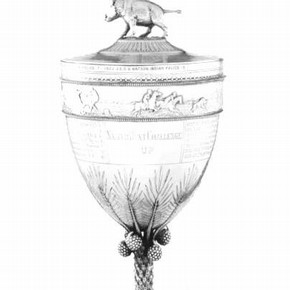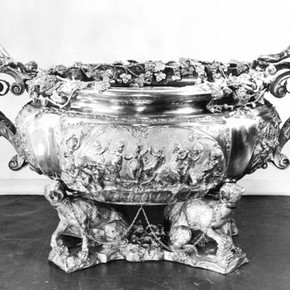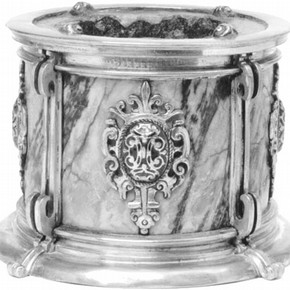Conservation Journal
January 1997 Issue 22
Reflections on Silver

Figure 1. The Nagpur Hunt Cup. Museum no. M.184-1976, approx. 40cm high. Photography by V&A Photographic Studio (click image for larger version)
The Oxford English Dictionary definition of a student reads: 'Person studying in order to qualify himself for some occupation or devoting himself to some branch of learning...' (I am also taken by a further, rather assumptive, definition - 'Person of studious habits' - but that is another matter). I read that the verb study involves 'making a study of, taking pains to investigate or acquire knowledge of [subject], or assuring [result sought], scrutinising or earnestly contemplating [visible object]'. In my first year of study I came to readily associate such a definition with the treatment of objects, but it was the treatment of objects for the Silver Gallery which helped me to begin to define conservation as a 'subject/branch of learning/occupation'.
My appreciation of the extent of involvement of a conservator in a major exhibition project began with the objects themselves. By considering them in the light of their new display I became aware of the wider issues surrounding the intensive preparation of a gallery refit on a grand scale. The first phase of the gallery will house some 1000 objects selected from about 12,000 objects in the Metalwork, Silver and Jewellery collection. The objects have been selected by the curators either as fine examples of design or craftsmanship or to convey a historical or educational message as in the discovery galleries (Figure 1).
One role of the conservator in this process is to survey the selected objects to assess their current state. This will, of course, affect a decision on how much time is required to treat each object. I began to appreciate the importance of accurate assessments of treatment times and just how difficult it is to be precise when some objects are too heavy to lift to inspect internally for corrosion, or when, on cleaning, hitherto disguised damage came to light (Figure 2). I discovered how crucial the role of 'conservator as actuary' was for time management in the conservation studio given that there are always other projects and loans to work on. These surveys also relate to other support teams, including scientists, photographers, object handlers and joiners, who have their timetables to maintain. Now I could see why planning for the gallery had begun in 1993.
I realised the need to allow time for research and analysis of individual objects. A tap into the curators' knowledge of an object is useful to help highlight historical features, such as use, which must be taken into consideration in selecting the treatments. We also need to ascertain which materials or techniques were used in construction of the object. An example of this is the cup shown in Figure 1. It had the raised relief heightened at the time of construction, by 'oxidation' of the silver giving a contrasting blue gray surface. This deliberate colouring of the surface had to be preserved while silver sulphide tarnish needed to be removed. The engraved areas showed remains of an infill used to highlight the letters - also to be retained - yet there was also a considerable build-up of previous cleaning residues which was obscuring some of the details.
Several of the other objects I worked on were of mixed media. This highlighted for me the need to be aware of the different approaches to conservation that diverse disciplines have, but most of all the need for communication between fellow conservators. Some of the other media I encountered were: fish skin, velvet, wood, stone, vegetable matter (a gourd), gems and enamels. I found the willingness of individuals to give their time very gratifying, for it is the people that count; books did not provide all the answers in a profession where so many exceptional objects exist and experience is often the key to the answer.
The ability to communicate well was also valid in any consultation with curators. These usually related to questions about what finish was deemed to be appropriate either for the condition or age of an object. For the display of a series of objects there might also be a discussion about the validity of certain repairs (old and new). Thought was also given to the suitability of mounting structures, in consultation with the joiners. One always had to balance the time available against the potential benefit the treatment might afford to the object.
In broader terms of communication I came to value highly the role of documentation, be it written or photographic. I would have dearly loved to know whether the corrosion of the gilded brass mounts on the inkwell in Figure 3, was a result of long term corrosion, or a reaction to previous cleaning processes. Time and circumstance ruled out further analysis, but a record of any prior conservation could have shed invaluable light onto our mystery.
Whilst working on the objects I was made increasingly aware of longer term considerations such as the environmental conditions or future handling of the objects. As we, the conservators, are the people most intimately acquainted with the objects I began to see that we have responsibility for maximising their chances of 'survival' by highlighting their specific needs in these areas. Time and time again I received objects which showed tarnish in the form of fingerprints, some severe enough to have etched the surface. Spreading the word about relatively minor preventive conservation issues became as important, in a way, as the large scale indoor environmental pollution monitoring programmes and research, which are vital considerations in any long term display plan (see the article by Simon Metcalf in this journal).
Repeatedly, it seemed to me that communication was the key: informing individuals as to the benefits of wearing gloves to prolong lacquers on the silver, discussing with the curators about the groupings of objects in cases to ensure that no incompatible objects were placed together, or talking with architects and the designers of the display cases to ensure that the most appropriate materials are used.
In a world increasingly dominated by balance sheets, I realised how controversial some decisions may be when budgets are restrictive. I could see how it is crucial to have a knowledge of as many options as possible in order to argue a case for a certain course of action. In the light of financial constraints I sense that it is easy for the conservator to feel thwarted. From what I have seen in the setting up of the Silver Gallery and listening to other conservators and museum staff at the recent ICOM-CC conference in Edinburgh, it seems more likely that the conservator needs to don yet another hat - that of an ambassador. More people need to know about the multifaceted job of the conservator - how else are potential sponsors going to learn about the vital role of conservation in the display of our nation's heritage? At the ICOM-CC conference one speaker's answer to that question was 'with the help of museums' 1 . The example of the display gallery in the Conservation Centre of the National Museums and Galleries of Merseyside is an exciting step in the right direction.
I have learned much through attending lectures, but just as invaluable has been the knowledge acquired through talking to people. It can often be a mutual learning process. There is a need to spread the word internally as well as externally. The cliché of 'educating the public' is simplistic: it implies teaching, instruction and training, which is all a bit too much to stomach for those not initially inspired by the notion of conservation. Nevertheless, taking a leaf from modern educational literature the aim could be to inspire or 'to make people become aware by information or from observation' (another Oxford English Dictionary definition - of the verb to learn).
We never stop learning and I am fortunate to be able to immerse myself in it presently. I am sure there will be thousands of visitors to the Silver Gallery who will be likewise absorbed. My only regret is that they will not receive quite as much information on the conservation concerns of the collection as was originally envisaged. However, we are getting there, with a debrief on the whole operation and the lessons learned, maybe other projects will give conservation the platform it deserves - and needs.
References
January 1997 Issue 22
- Editorial
- Weighing up silver objects: evaluating past and future conservation methods
- Reflections on Silver
- Investigations into the Use of Laponite as a Poulticing Material in Ceramics Conservation
- Nappies at the National Museum of Childhood
- Mounts for the Display of Books
- The Archive of Heal & Son Limited
- Slides and Frisbees - Determining Dust Deposition Rates
- Summer Placement at the Canadian Conservation Institute
- Summer Placement at the Central Research Laboratory for Objects of Art and Science, Amsterdam
- Printer Friendly Version

